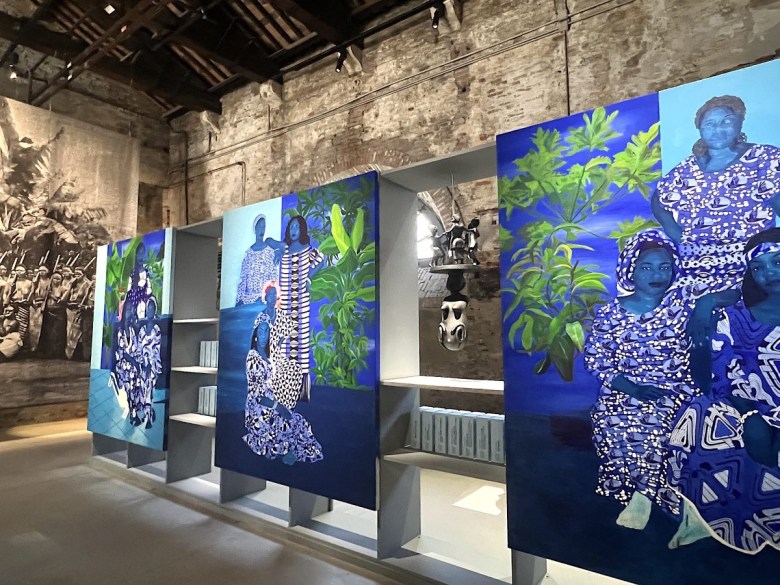VENICE — Still in 2024, inclusion in La Biennale de Venezia remains an honor. It’s a symbol of recognition, legitimacy even, in the contemporary art world — something of which the curators and artists of Benin’s premiere pavilion are acutely aware. However, recognition isn’t what the pavilion’s organizers, a curatorial team led by Azu Nwagbogu, are persuaded by. Everything Precious Is Fragile, as the exhibition is titled, is an opportunity to collapse conventions and expectations through works by artists Chloé Quenum, Moufouli Bello, Ishola Akpo, and Romuald Hazoumè.
The Francophone West African nation of Benin sits firmly between the Yoruban provinces of Nigeria and Togo. It is largely identified as the birthplace of voodoo, known for its historical relationship to the Atlantic slave trade and for its Gelede masks that have become a Pan-African trope, “a very commodified, commercialized, objectified version of something that must be deeper,” Nwagbogu told Hyperallergic while standing outside the Arsenale pavilion, the first to follow the main show in the vast shipyard venue.
These cultural expressions have become “the cliches of Benin,” he added. Interestingly, France’s 2021 restitution of 27 of the so-called “Benin Bronzes” looted from Benin City in present-day Nigeria, which have come to define Benin in the global popular imagination, paved the way for the Venice pavilion.
Nwagbogu unexpectedly received a call, followed by an email, from the president of Benin asking him to spearhead the debut exhibition back in December 2022. Though not from Benin, Nwagbogu, who self-identifies as “Western-educated from Anglophone Africa, of Nigeria,” is known for his novel, progressive approach to reconceptualizing the issues of decolonization, repatriation, and restitution. And he was handed “a carte blanche” for the curatorial direction without an agenda or specific messaging asks.

So Nwagbogu did what any inquiring mind would do: He talked to the people of Benin, les Béninoise. He met with traditional rulers (all men) on a curatorial listening tour of the country, where he’s lived on and off for the past year. “It was heuristic research — I’d ask ‘how do we feel about slave trade and the history of it?’” Nwagbogu told Hyperallergic. “All of them had some complicity and guilt. I was really amazed by that. We’re not guilty. We didn’t do the things that happened. We can’t do anything about the past. But we can do something about the future.”
Yet that wasn’t the sole, or even the most revealing, thread that emerged. “They all said to me that the reason the world was out of kilter, and all of these have happened, was because women have been displaced from a position of power and authority. These were men sharing this idea with me.” And that’s when Nwagbogu decided to court the cliché, beginning with Gelede masks (themselves symbols and materials of Yoruba culture celebrating women ancestors and deities) and conceive a biennial exhibition about Beninoise feminism.

For starters, the pavilion introduces the concept of “rematriation” — a notion associated with Indigenous women-led communities around the world — through series such as Akpo’s Traces of a Queen (2024) and Night Birds (2022) by Moufouli Bello, which center women as the spiritual and social center, regal and dignified portraits marking their power.
Everything Precious Is Fragile elevates and empowers the postcolonial experience, moving away from a sense of being defined by the past, or as the pavilion commissioner José Pliya said, quoting the Senegalese politician and poet Léopold Sédar Senghor: “at the great ‘rendez-vous of giving and receiving.’” Artist Chloe Quenum, speaking in French at the preview, went further. “I’m Beninoise, I am French, I’m an artist, I’m a woman, it’s my life. I want people to understand the complexity of identity, the question of visibility and invisibility.”

All of these realities exist together as one, undermining the hierarchies of history. The sticky irony about biennials is that they often demand the viewer to reflect — on oneself, the condition of art production, the state of the world — without turning the mirror back onto itself. Quenum’s L’heure Blue (2024), a series of cultural objects rendered in glass (such as a drum and a broom) centered in front of a bay window that’s staged in front of the Arsenal’s own bay window, doesn’t let Venice get away with its own uncomfortable past. It’s a confrontation of “Venice’s own role in the history of slavery,” Quenum reminds us. (Il Arsenale is where the ships of colonialism were built, lest we forget.)
As Benin’s first go at the Biennale reveals, the tides of history always roll in, bringing with them new ways of seeing.

